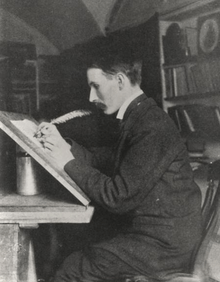Edward Johnston

Edward Johnston, CBE (11 February 1872 – 26 November 1944) was a British craftsman who is regarded, with Rudolf Koch, as the father of modern calligraphy, in the particular form of the broad edged pen as a writing tool. He is most famous for designing the sans-serif Johnston typeface that was used throughout the London Underground system until it was re-designed in the 1980s. He also redesigned the famous roundel symbol used throughout the system.
Early life
Johnston was born in San José, Uruguay.[1] His father, Fowell Buxton Johnston (born 1839) was an officer in the 3rd Dragoon Guards, and the younger son of Scottish MP Andrew Johnston and his second wife, abolitionist Priscilla Buxton, daughter of Sir Thomas Fowell Buxton, 1st Baronet. Johnston's uncle (his father's elder brother), also Andrew Johnston, became an MP in Essex in the 1860s.
The family returned to England in 1875. With his father seeking work, and his mother ill, Johnston was raised by an aunt. He was educated at home, and enjoyed mathematics, technology, and creating illuminated manuscripts. His mother died in 1891, and he began to work for an uncle. He spent some time studying medicine at Edinburgh University but did not complete the course.
After his mother's death, his father was remarried, to a sister of Robert Chalmers, 1st Baron Chalmers. Johnston's half-brother, Andrew Johnston (1897-1917), was killed when his aeroplane crashed while serving in the Royal Flying Corps in the First World War.
Career
After studying published copies of manuscripts by architect William Harrison Cowlishaw, and a handbook by Edward F. Strange, he was introduced to Cowlishaw in 1898 and then to William Lethaby, principal of the Central School of Arts and Crafts. Lethaby advised him to study manuscripts at the British Museum, which encouraged Johnston to make his letters using a broad edged pen. Lethaby also engaged Johnston to teach lettering, and he started teaching at the Central School in Southampton Row, London, in September 1899, where he influenced the typeface designer and sculptor Eric Gill. From 1901 he also taught a class at the Royal College of Art and many students were inspired by his teachings.
He published a handbook, Writing & Illuminating, & Lettering in 1906. He started a second book in the 1920s but it was unfinished at his death. In 1913, Frank Pick commissioned him to design a typeface for London Underground, and the simple and clear sans-serif Johnston typeface was the result.
He has also been credited for reviving the art of modern penmanship and lettering single-handedly through his books and teachings. Johnston also devised the simply crafted round calligraphic handwriting style, written with a broad pen, known today as the foundational hand (what Johnston originally called a slanted pen hand, which was developed from Roman and half-uncial forms). He was influential on a generation of British typographers and calligraphers, including Graily Hewitt, Irene Wellington, Harold Curwen and Stanley Morison, Alfred Fairbank and Eric Gill. He also influenced the transition from Gothic to Roman letters in Germany, and Anna Simons was a student. He also lectured in Dresden in 1912. In 1921, students of Johnston founded the Society of Scribes & Illuminators (SSI), probably the world's foremost calligraphy society.
Private life
He met Greta Grieg, a Scottish schoolmistress, in 1900, and they were married in 1903. They had three daughters. They lived in London until moving to Ditchling, Sussex in 1912, where Eric Gill had settled in 1907. His wife died in 1936. He was appointed a CBE in 1939. He died at home in Ditchling.[2]
Publications
- Johnston, Edward (1995). Writing & Illuminating & Lettering. Dover Publications. ISBN 0-486-28534-0.
- Johnston, Edward (1986). Lessons in Formal Writing. Taplinger Publishing Company. ISBN 0-8008-4642-7.
- Johnston, Edward (1990). Decoration and Its Uses. Tenspeed. ISBN 0-89815-401-4.
- Johnston, Edward (1909). Manuscript & Inscription Letters. London: John Hogg.
- Johnston, Edward (1914). The House of David, his Inheritance: A Book of Sample Scripts.
- Johnston, Edward. Formal Penmanship.
- Johnston, Edward (1915). A carol and other rhymes. London: Hampshire House Workshops.
References
- ↑ "Font Designer — Edward Johnston". Linotype GmbH. Retrieved 5 November 2007.
- ↑ The Eric Gill Society: Associates of the Guild: Edward Johnston
Further reading
- Holliday, Peter (2007). Edward Johnston: Master Calligrapher. London: British Library Publishing. ISBN 978-0-7123-4927-7.
External links
| Wikimedia Commons has media related to Edward Johnston. |
- The Legacy of Edward Johnston at www.ejf.org.uk The Edward Johnston Foundation
- Edward Johnston's works held at the Central Saint Martins Museum and Study Collection
- Edward Johnston at the Crafts Study Centre
- National Portrait Gallery Edward Johnston, 1937
- London's Transport Museum Photographic Archive Example of condensed form Johnston font used on a bus blind
- Edward Johnston Collection held by the Crafts Study Centre and hosted online by the Visual Arts Data Service (VADS)
|